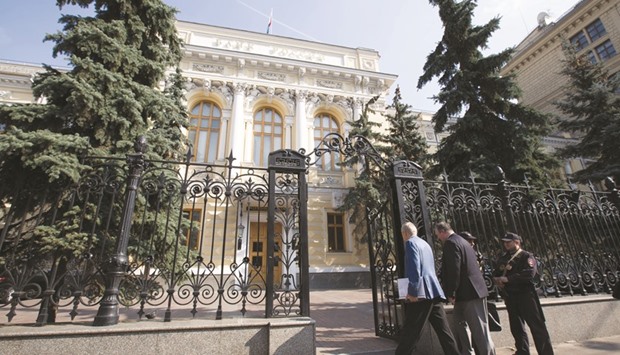As the clock ticks down to Russia’s final meeting on interest rates in 2016, the central bank is looking beyond not just this year but also next.
Once consumer-price growth settles at 4%, a target the central bank wants to reach by the end of 2017, and inflation expectations stabilise near the same level, the key rate will be kept at 6.5% to 6.75%, said Alexander Morozov, head of its research and forecasting department. The Bank of Russia will leave its benchmark at 10% at a meeting on Friday, in line with a pledge made three months ago, according to 18 of 19 economists surveyed by Bloomberg, with one predicting a cut to 9.75%.
“By providing a specific level for the key rate, the Russian central bank sends a very strong signal regarding its intentions,” said Piotr Matys, an emerging-market currency strategist at Rabobank in London. “However, forward guidance could be a source of risk.”
The central bank is digging in after issuing an unprecedented commitment in September to hold rates through the rest of the year after only two reductions in 2016. Governor Elvira Nabiullina said this month that the next rate cut isn’t likely before the first or second quarter, with monetary policy set to remain “moderately tight” over the next year and a half.
Inflation has been the keystone of policy for the Bank of Russia, which overshot its forecasts for a fourth year in 2015. It eased more than forecast last month to 5.8%, the lowest annual level in more than four years.
Policy makers won’t change the benchmark rate to address small deviations from their inflation target when that goal is met, Morozov said on Friday in Moscow at a conference.
Forward-rate agreements are signalling 54 basis points of decreases in borrowing costs during the next three months, the most since early September. The key rate will end next year at 8.25% and fall to 8% in the second quarter of 2018, according to a Bloomberg poll of economists.
The central bank sees price growth averaging 4% in the two years after achieving its inflation target in 2017, according to Morozov. Policy makers are set to enter 2018 with their benchmark above 6.5% to 6.75% because inflation expectations remain too high, he said. While declining to the lowest in two years in October, they rose last month, with the median value of expectations for a year ahead still at more than triple the target.
“The experience of other countries that have switched to inflation targeting shows that the process of anchoring inflation takes two to three years,” Morozov told reporters. “We’ll try to reduce this. It depends on how actively we work with businesses and the population.”
The Bank of Russia may be walking into a policy minefield of its own making. Recent attempts by global central bank at so-called “forward guidance” – telling the public how interest rates will evolve in the future – have arguably caused more confusion than clarity when shifts in the economy forced officials to change their plans.
An early initiative by Governor Mark Carney, when he arrived at the Bank of England in 2013, was aimed at giving clarity over how long borrowing costs would stay low. He abandoned the initial pledge in early 2014 as unemployment fell faster than forecast, switching to a new language of “limited and gradual” rate increases, before later being labelled an “unreliable boyfriend” for mixed messages on the policy outlook.
“Forward guidance can prove a tricky tool,” Rabobank’s Matys said. “Sometimes it’s better to keep the markets in the dark and not provide too much information.”
The risk in Russia is that the central bank underestimates the speed of disinflation next year, holding rates so high that they keep “the economy excessively weak” just as it tries to break free of recession, according to Capital Economics.
The stance also supports the appeal of the rouble’s so-called carry trade, in which investors borrow in countries where rates are low and invest in higher-yielding assets.
The Russian currency provides the best carry trade in the world after the Brazilian real. The rouble is the world’s best performer this year with a gain of 20% against the dollar.

Visitors pass security to enter the headquarters of Russia’s central bank in Moscow. The Bank of Russia will leave its benchmark at 10% at a meeting on Friday, in line with a pledge made three months ago, according to 18 of 19 economists surveyed by Bloomberg.
